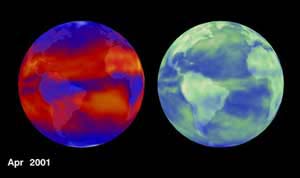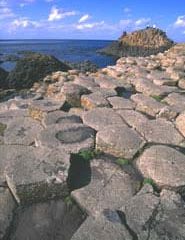Earth Sciences
Earth Sciences (also referred to as Geosciences), which deals with basic issues surrounding our planet, plays a vital role in the area of energy and raw materials supply.
Earth Sciences comprises subjects such as geology, geography, geological informatics, paleontology, mineralogy, petrography, crystallography, geophysics, geodesy, glaciology, cartography, photogrammetry, meteorology and seismology, early-warning systems, earthquake research and polar research.

European low-ozone event reveals worrying trend
For several days last week, the protective ozone layer over Europe thinned considerably. Scientists monitoring ozone coverage using a rapid mapping technique based on data from the GOME (Global Ozone Monitoring Experiment) instrument aboard ESA`s ERS-2 satellite detected finger-like ozone thinning over Europe.
“From 28-30 January, we observed a pronounced `streamer event`,” explains DLR`s Thilo Erbertseder, “where streamers of tropical air pushing up from the equatorial regions spread over s

Equatorial water belt slackens
30 years of slowing Pacific circulation may have changed climate
A recent slowing in the circulation of Pacific Ocean waters could have raised Pacific sea surface temperatures. It may even mean that less carbon has reached the atmosphere from the ocean surface over the past two decades.
Across the Pacific, water circulates in two giant loops in the Northern and Southern Hemispheres. It flows from the subtropics to the tropics about at a depth of 100-400 metres, rises to the

Studies Raise Questions about Climate Change
Climate prediction just got trickier, according to two new studies appearing in the current issue of the journal Science. Analysis of more than two decades of satellite data shows that more sunlight entered the tropics and more heat escaped to space in the 1990s than a decade earlier. Moreover, current climate models fail to account for the new findings, suggesting that they may contain more uncertainty than previously thought.
For the earth’s climate to remain unchanged, the planet’s ener

Climate change following collapse of the Maya empire
Researchers from the University of Amsterdam have demonstrated that the climate in South Mexico changed following the collapse of the Maya empire. From preserved pollen grains the paleoecologists could deduce that the climate quickly became dryer.
The climate becoming dryer, explains the decrease in the population following the collapse of the Maya empire. The climate researchers have therefore helped to solve an archaeological mystery.
With the help of pollen grains, the paleoeco

Stress relief caused Giant’s Causeway
Ireland’s huge hexagonal columns are a natural consequence of lava cooling.
The Giant’s Causeway is not the work of men or monsters, but a natural consequence of how lava cools and solidifies, new computer simulations suggest.
The causeway is a field of roughly hexagonal basalt columns up to 40 feet high on the shores of County Antrim in Northern Ireland. It arose when a flow of volcanic rock split into hexagonal columns to relieve stress, according to Eduardo Jagla

Floodplains expert to train African environment managers
The delicate balance of life and death in Africa is nowhere more evident than on the banks of the continent`s mighty rivers. Rural communities depend on the rich silt brought down by rivers for farming but they are also at risk of devastating floods, as are urban dwellers in informal settlements that are often built on floodplains.
Dr Sue Marriott, reader in earth sciences at UWE`s Faculty of the Built Environment, is setting off this month to help with training environmental managers in fl